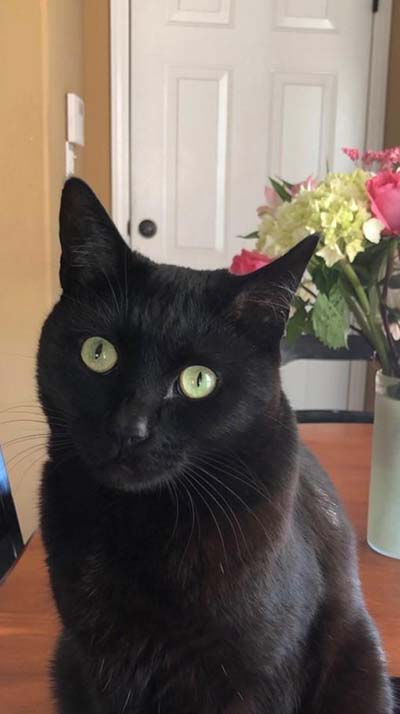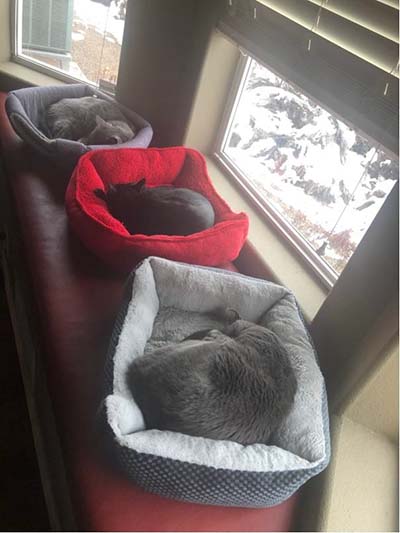Cat frat hazing or attempted murder?
Karen and Richard loved “Larry” and Curley”, a couple of fuzzy BFFs who’d shared their home with them since kittenhood, eight years earlier. Everybody snuggled. It was feline nirvana. Then a college student they knew needed to move and couldn’t keep his kitty, 2 year old “Moe”. Mmm, they reasoned. This could work. So they dropped by Moe’s house to size him up and, wow, another sweet cat who loves to cuddle! What could go wrong?
What Richard and Karen didn’t understand is that Larry and Curley, having never shared their indoor lives with anybody but each other, had developed permanent brain networks that supported only their little world. Cats are actually programmed to live in colonies – “villages” that raise the youngsters. Some adolescents and adults come and go. Those living in this type of fluid environment, including permanent residents in feline foster homes, do fine with newbies. Sadly, Larry’s and Curly’s lifelong sheltered existence caused them to regard outsiders as threats that needed to be exterminated or at least driven to the next county. No discussion, no debate.
This can be a difficult concept to grasp. We love our pets like little people in furry suits. Shouldn’t they behave that way? A lap sitting, heart – to – heart on the merits of kindness and peaceful coexistence should get the message across, shouldn’t it? The fly is this ointment is that cats don’t think that way. They’re members of a different species. They don’t even speak a human language.
Having consulted Dr. Google, the renowned purveyor of urban drivel, Richard and Karen were prepared. They fed and petted their cats, Moe on one side of a door, Larry and Curley on the other. A few days later they opened the door a crack and repeated the process until they felt a winning vibe. That’s when they learned the true meaning of loathing. Curley and Larry, screaming like banshees, launched a full-on assault at poor unsuspecting Moe. Overwhelmed by panic and guilt, our well-intentioned cat parents sprang into action hoping to prevent the disemboweling and dismembering of their beloved cats.
Immigration hate crime – can’t we just get along?
The combatants were in their corners; the cacophony of cussing and the hurling of insults had ended. Somehow, each cat emerged remarkably unscathed. Their well-intentioned humans, on the other hand, suffered blood loss, although relatively minor.
Richard and Karen had made the common mistake of hoping for a Disney ending to a complex behavior challenge. Their plan had been to quickly and easily integrate Moe into Larry’s and Curley’s lives. They’d had cats for years and had never seen this problem. Couldn’t everybody just join paws around the campfire and sing kumbaya? Their emotions in tatters, they called my office to report a hate crime.
Our consultation began with me listening carefully as Karen and Richard vented their frustration and grief. Was there any hope? I explained that cats can quickly associate intense fear and hostility with just the sight of a former adversary. They’d done the right thing by immediately separating their pugilists, making it possible for them to start the long process of abandoning their animosity. I made it clear that we don’t succeed in every case but there had only been one knockdown, drag-out so far. If they followed instructions and proceeded slowly, we had a chance.
Moe, it turned out, was not the only alien. For years, a neighbor cat had been skulking in the yard, sauntering past the windows and occasionally leaping onto a windowsill to leer at the feline occupants. She must have been disappointed. Rather than rushing the glass, hissing and spitting like some besieged indoor kitties, Larry and Curly shrunk into their under-the-furniture lairs. Moe’s arrival was the last straw for these frightened, xenophobic isolationists.
Larry struggled most. He imploded with any visitor; delivery people sent him diving for cover. As we pealed back the layers of this behavioral onion I learned that he growled and sometimes lunged at Curley for the audacity of moseying past while he was eating or sleeping. What a grouch!
Could Larry, Moe, & Curley ever feel good enough to behave?
Problems with any organ system can impact the firing of the brain’s neurons. Oral pain is a frequent offender but arthritis, ear infections, itchy skin, and nausea are also common. Moe, the 2 year old feline interloper, passed his physical exam with flying colors. Curley’s was normal too. But Larry? His gums were suffering from nasty, long-standing infection. It even hurt when he laughed, poor guy.
I told Karen and Richard how insidious dental disease can be while assuring them that Larry would be OK. When he felt better we could be hopeful that he would behave better too. We got his procedure scheduled quickly.
Keeping interior doors closed and rotating these little sneakers between rooms was difficult. I get it; my cats have never been rule followers either. But the longer Richard and Karen could keep Larry and Curley from having even visual contact with Moe, the more likely mutually assured destruction could be avoided later.
Larry said farewell to 5 of his choppers. His gums were sutured, he recovered quickly from anesthesia, and started at-home oral liquid pain medication and an antibiotic. A week later he was playing like a kitten. His snarky behavior toward his old friend Curley ended but they were still nervous wrecks when FedEx showed up at the door. If we could achieve emotional stability for jumpy Larry and shrinking Curley, they’d have a shot at détente with Moe or, at the very least, a lasting ceasefire.
I urged my clients to enrich their cats’ home environment with a plethora of simulations of wild predatory, hiding, climbing, and perching opportunities. (drjeffnichol.com/feline-environment-enrichment). Dr. Google doesn’t know this stuff. He/she/they aren’t residency trained in veterinary behavior medicine. In fact, he/she/they aren’t a doctor of any sort.
We still had a couple of kitties whose neurochemistry needed all the help I could provide. For anxious and reactive Larry I prescribed venlafaxine. To reduce Curley’s stress and to help build his confidence I started him on buspirone. The neighborhood agitator who haunted the windows? She was now persona non grata.
A delicate truce is still a truce
With Larry’s teeth and gums no longer a source of pain; modern medicine cm through again to lift his oppressive anxiety. Curley gained confidence and was learning to relax – out from under the bed. They were still kept separated from Moe, while swapping halves of the house with him. Perching on floor-to-ceiling cat trees and venting their predatory proclivities on stalk and pounce toys had all of them feeling like real cats.
Fulfilling lives for these former feline foes reduced their collective angst and diminished the risk of nuclear conflict. Keeping the peace, on the other hand. would be a lifelong challenge. For these gentlemen to ever safely comingle, they would also need alone time. Cats are social creatures, but only to a point.
Richard was pretty handy. I advised him on building and installing hide boxes at various heights in different rooms. Much like their wild brethren, these kitties could sneak away and meditate. Some of the time we can only guess at what they’re thinking; they guard secrets we’ll never unravel.
Moe lived his previous life largely outdoors. He needed to stay inside at his new home because it was located near a busy street. If he felt trapped inside he could wig-out. The compromise was a generous-sized outdoor catio with tall climbing structures and a few hide boxes. A cat door allowed Moe to escape to his playground, steering clear of Larry and Curly, the militants within.
Karen and Richard were committed. During catio construction they mounted a Scare Crow Animal Deterrent booby trap on their fence to discourage the prowling neighbor cat from agitating what was likely to become a delicate truce among Larry, Moe, and Curley.
We now had a foundation for success. I counseled my clients to very slowly, over several weeks, bring Larry and Curley incrementally closer to one side of a covered baby gate, while Moe camped out on the other side. During twice daily controlled exposures the boys would enjoy snacks and gentle petting. Gradually the sheet covering the gate was raised and later eliminated. When the Berlin wall finally came down Larry and Curley went about their lives as though Moe didn’t exist. And, hey, a gin rummy tournament was never in the cards for these guys anyway. Karen and Richard declared victory and went about their lives too, always with one eye out for smoldering turmoil.
For help with behavior problems, you can sign-up for a Zoom Group Conference on my website, drjeffnichol.com.
Dr. Jeff Nichol is a residency-trained veterinary behaviorist. He provides consultations in-person and in groups by Zoom (drjeffnichol.com). Each week he shares a blog and a video to help bring out the best in pets and their people. Sign up at no charge at drjeffnichol.com. Post pet questions through my website, drjeffnichol.com/contact/ or by US Post to 4000 Montgomery Blvd. NE, Albuq, NM 87109.





